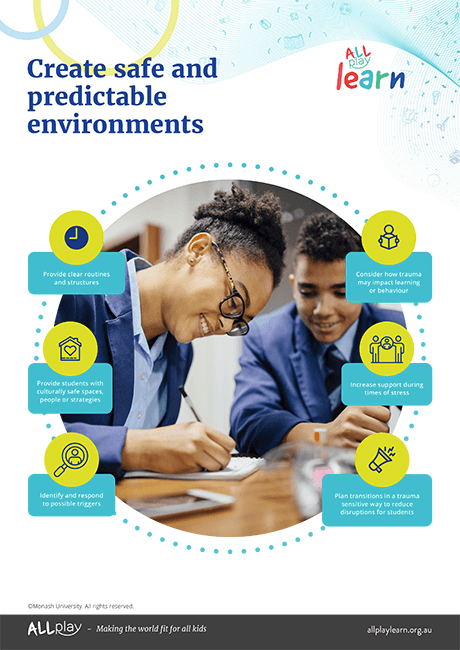Creating trauma-sensitive school environments
Trauma sensitive school environments create inclusive environments for students and their families who have experienced trauma or marginalisation. We encourage schools and teachers to reflect on how the strategies for creating trauma sensitive environments below could be implemented in your school.

Create safe and predictable environments

- Provide clear routines and structures to foster predictability and consistency. For example, visual schedules; informing students of changes to routine in advance.
- Consider the ways in which trauma may disrupt learning and behaviour, such as a student’s attention and concentration, or emotion regulation and coping skills.
- Create feelings of safety through collaborating with students to identify safe spaces, people or strategies they can access if overwhelmed or distressed.
- Increase support during times of stress. For example, transitions.
- Seek to identify and respond to possible triggers. For example, harsh discipline; family-focused activities such as family trees; topics centred around race, discrimination or violence.
- Provide early warnings that a difficult topic will be covered. For example, contact families.
- Allow time for proactive planning. For example, collaborate with students, their families and involved professionals to provide choices in literature or learning activities, or increase supports available to the student.

Empower students

- Identify, acknowledge and develop students' character and learning strengths.
- Provide social-emotional learning that covers emotions, coping skills and managing challenges.
- Let students set goals, make choices, and be a part of decision making.
- Respect student autonomy and provide opportunities for collaboration and their voice to be heard (for example, ask for their opinion or views).
- Allow students to choose a safe and trusted person at school whom they can go to if distressed or overwhelmed.

Commit to a trauma-informed school culture

- Develop a culture of humility, empathy, responsiveness, awareness and sensitivity to the ways in which school policies, practices and processes may cause harm or distress.
- Do not tolerate jokes or stereotypes based on gender, race, cultural background, disability, sexuality, family status or other factors for which a student may have experienced stigma, discrimination or other trauma.
- Promote strong, trusting relationships among all members of the school community.
- Ensure all staff participate in professional learning related to trauma and their legal responsibilities and mandates in relation to trauma.
- Focus on the wellbeing of all members of the school community, including staff, particularly in times of stress.
- Collaborate with professionals to build early and respectful trauma screening and intervention into school processes.
- Consider the ways in which school policies, practices and processes may cause harm or distress.

Build school connectedness

- Provide time for students to have positive interactions with peers and staff.
- Avoid judgements and negative or unhelpful predictions (for example, “you will get over this”).
- Do not ask for more detail or information about traumatic experiences, or share your own*, as this can be traumatising in itself. Instead staff listen and validate feelings and experiences shared by a student with empathy.
- Develop warm, secure and accepting relationships with students that builds (and maintains) the trust of students.
- Model positive relationships with all members of the school community.
- Celebrate and incorporate diversity and cultural identities.
* For some students from collectivist cultures, such as Aboriginal and Torres Strait Islander students, having someone from within their community or culture share that they faced similar challenges or trauma can provide a sense of shared understanding and community. This should be done sensitively, with limited detail of the event (i.e., do not provide explicit details that may be traumatising), and only by those who share the same cultural identity.

